renal physiology 魏版
physiology系列单词
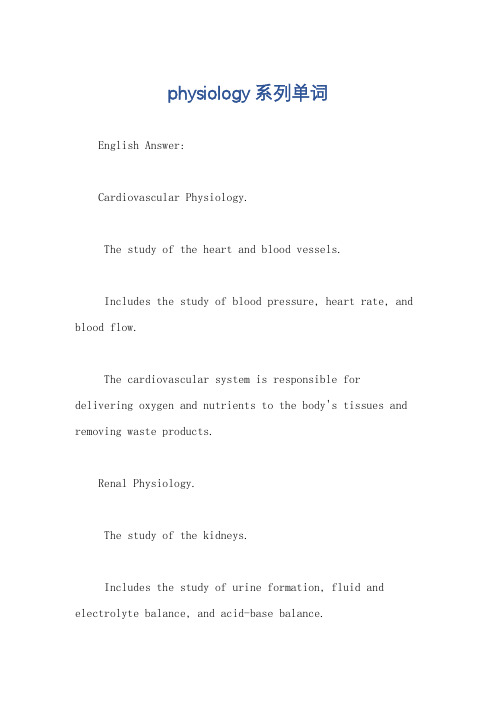
physiology系列单词English Answer:Cardiovascular Physiology.The study of the heart and blood vessels.Includes the study of blood pressure, heart rate, and blood flow.The cardiovascular system is responsible for delivering oxygen and nutrients to the body's tissues and removing waste products.Renal Physiology.The study of the kidneys.Includes the study of urine formation, fluid and electrolyte balance, and acid-base balance.The renal system is responsible for filtering blood, removing waste products, and regulating fluid and electrolyte balance.Respiratory Physiology.The study of the lungs and breathing.Includes the study of gas exchange, lung volumes, and respiratory mechanics.The respiratory system is responsible for exchanging oxygen and carbon dioxide between the blood and the air.Gastrointestinal Physiology.The study of the digestive system.Includes the study of food digestion, absorption, and excretion.The gastrointestinal system is responsible for breaking down food into nutrients that can be absorbed into the bloodstream.Endocrine Physiology.The study of the endocrine system.Includes the study of hormones, their secretion, and their effects on target tissues.The endocrine system is responsible for regulating a wide range of bodily functions, including metabolism, growth, and reproduction.Neurophysiology.The study of the nervous system.Includes the study of neurons, synapses, and neural circuits.The nervous system is responsible for controlling movement, sensation, and thought.Neuromuscular Physiology.The study of the interaction between the nervoussystem and the muscular system.Includes the study of motor neurons, muscle fibers,and neuromuscular junctions.The neuromuscular system is responsible forcontrolling movement.Reproductive Physiology.The study of the reproductive systems.Includes the study of gamete production, fertilization, and pregnancy.The reproductive system is responsible for producingoffspring.Immunology.The study of the immune system.Includes the study of white blood cells, antibodies, and antigens.The immune system is responsible for protecting the body from infection.Physiology of Homeostasis.The study of how the body maintains a stable internal environment.Includes the study of thermoregulation, fluid and electrolyte balance, and acid-base balance.The homeostatic mechanisms of the body work together to maintain a stable internal environment that is essentialfor survival.中文回答:生理学。
医学英语新教程(下册)课文翻译

医学英语新教程(下册)课文翻译UNIT1疾病的介绍1人体是一个艺术的杰作。
我们对身体的功能了解越深,就越赏识。
即使在生病时,身体在故障修复和补偿方面表现也相当出色。
身体内不断发生变化,然而,一个叫内环境稳定(稳态)的平稳状态能大抵保持平衡。
机体内环境稳定出现某种重大的紊乱,就能引起各种各样的反应,这些反应常常促使疾病的体征和症状出现。
比如,由于运动员对氧气的需求增加,他们体内的红细胞计数就会异常升高。
这是一个使更多血红蛋白循环的自然补偿机制,但它却是红细胞增多症的一个症状。
2当一个器官需要做更多工作时,它往往会增大,肥大。
心脏会因为长期的高血压而增大,因为它必须不间断地克服巨大的阻力把血液输送到全身。
当瓣膜存在缺陷时,心肌同样也会肥大,因为那些要么太宽,要么太窄的瓣膜需要额外的抽吸作用。
如果一个肾衰竭了,另一个肾就会增大以满足身体的需要,并弥补那个有缺陷的肾。
当流向这两个肾的血液不足时,它们会通过分泌荷尔蒙(激素)的方式帮助血压升高。
然而,如果某个器官或身体的某个部位没有得到使用,它就会萎缩,或者,也就是说,面积变小或功能下降。
3血液在维持内环境稳定方面发挥着几个作用。
当组织受到创伤,损伤,或者感染时,血流就会积聚在受损区域。
这是极其重要的,因为血液携带了专门用于清除有害物质和细胞碎片的细胞。
血液中的其他细胞则产生抗体,以抵抗致病生物的入侵。
5关于疾病,一个重要方面是它的病因学或病因。
许多熟悉的疾病是由病原体造成的。
普通感冒和流感都是病毒感染,但是脓肿和脓毒性咽喉炎是由细菌造成的,而真菌和寄生虫分别是运动员足部疾病和蠕虫病的病原体。
一种疾病或异常病变的原因及进展称之为疾病的发病机制。
6病理学是研究疾病特点、原因和影响的一个医学分支。
细胞病理学家研究的是细胞或显微镜的变化,而临床病理学家则利用实验室试验和方法进行诊断。
一位病理学家可能专长于验尸或手术上的研究结果。
7许多疾病是由遗传造成的,经缺陷基因遗传。
生理学(Physiology)PPT课件

G.J. Tortora & S.R. Grabowski, HarperCollins Pub.Inc. 1996
6. Human Physiology: the mechanisms of body function, 7th ed,
A. Vander, J. Sherman & D. Luciano, McGraw-Hill Co. Inc., 1998
3
实验课内容(21学时)
实验1. 坐骨神经腓肠肌标本制备 骨骼肌的单收缩与复合收缩(蛙)
实验2. 皮层运动区刺激效应、去大脑僵直(兔) 实验3. 小白鼠脊髓半横切术与观察、毁小脑术 实验4. 离体蛙心灌流 实验5. 动脉血压的神经体液调节(兔) 实验6. 呼吸的反射性调节(兔) 实验7. 尿生成的影响因素(兔)
11. 生理学实验指导 赵轶千 王雨若 人民卫生出版社 1985
12. 生理学实验
解景田 谢申玲 高等教育出版社 1987
13. 生理学方法与技术 周衍椒 赵轶千 王雨若 科学出版社 (第一集) 1984; (第二集) 1984; (第三集) 1987
14. 现代生理学实验教程
沈岳良
科学出版社 2002
更接近生理情况。
11
第二节 人体的基本生理功能
生物体(包括人体)的活动有三大基本 特征:
新陈代谢 兴奋性
生殖(自我繁殖)
12
一. 新陈代谢(新老交替,不断地自我更新) • 同化作用:
– 机体不断地从外界环境中摄取营养物质合成 自身物质的过程
• 异化作用:
– 机体分解自身物质,把分解产物排出体外, 并在物质分解时释放能量,供机体生命活动 的需要
17
生物体对环境变化作出适宜反应,是一切 生物体普遍具有的功能,也是生物能够生存的必 要条件。
(完整版)药学英语第五版原文翻译
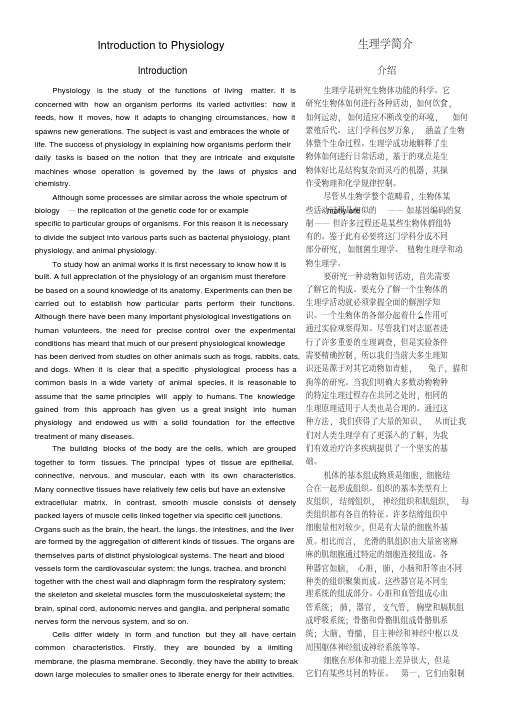
conditions has meant that much of our present physiological knowledge
行了许多重要的生理调查,但是实验条件
has been derived from studies on other animals such as frogs, rabbits, cats, 需要精确控制,所以我们当前大多生理知
细胞在进化过程中不断分化进行不同
enzymes. During embryological development, this process of 的功能活动。 有些细胞具有收缩能力 (如肌
differentiation is re-enacted as many different types of cell are formed 细胞),有些可以传导电信号(如神经细
Thirdly, at some point in their life history, they possess a nucleus which
膜包被, 即细胞质膜; 第二, 细胞有把大分
contains genetic information in the form of deoxyribonucleic acid (DNA). 子分解为小分子来释放活动所需能量的能
nerves form the nervous system, and so on.
成呼吸系统;骨骼和骨骼肌组成骨骼肌系
Cells differ widely in form and function but they all have certain 统;大脑, 脊髓, 自主神经和神经中枢以及
common characteristics. Firstly, they are bounded by a limiting 周围躯体神经组成神经系统等等。
Renal Physiology
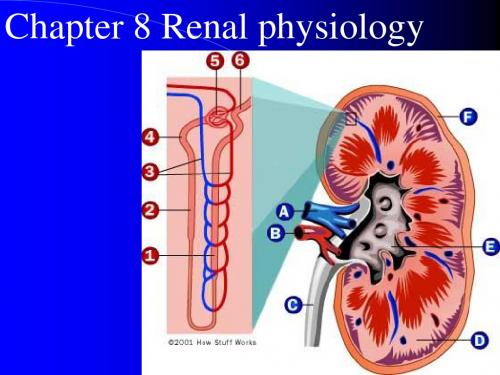
HUMAN RENAL PHYSIOLOGY
• Functions of the Kidney:
– Excretion:
– Loss of fluid from body in form of urine Amount = Amount + Amount -- Amount of Solute Filtered Secreted Reabsorbed Excreted
Functions of the Nephron
Reabsorption Secretion Excretion
Filtration
HUMAN RENAL PHYSIOLOGY
• Four Main Processes:
– Filtration – Reabsorbtion
– Secretion
Factors that determining the glumerular filterability 1.Molecular weight
2.Charges of the molecule
Filtration Membrane
–One layer of glomerular capillary cells –Basement membrane
Anatomy of Kidney
Cortical nephron – glomeruli in outer cortex & short loops of Henle that extend only short distance into medulla-- blood flow through cortex is rapid – majority of nephrons are cortical – cortical interstitial fluid 300 mOsmolar Juxtamedullary nephron – glomeruli in inner part of cortex & long loops of Henle which extend deeply into medulla.– blood flow through vasa recta in medulla is slow – medullary interstitial fluid is hyperosmotic – this nephron maintains osmolality in addition to filtering blood and maintaining acid-base balance
药学英语第五版原文翻译

药学英语第五版原文翻译Introduction to PhysiologyIntroductionPhysiology is the study of the functions of living matter. It is concerned with how an organism performs its varied activities: how it feeds, how it moves, how it adapts to changing circumstances, how it spawns new generations. The subject is vast and embraces the whole of life. The success of physiology in explaining how organisms perform their daily tasks is based on the notion that they are intricate and exquisite machines whose operation is governed by the laws of physics and chemistry.Although some processes are similar across the whole spectrum of biology—the replication of the genetic code for or example—many are specific to particular groups of organisms. For this reason it is necessary to divide the subject into生理学简介介绍生理学是研究生物体功能的科学。
它研究生物体如何进行各种活动,如何饮食,如何运动,如何适应不断改变的环境,如何繁殖后代。
药学英语第五版原文翻译
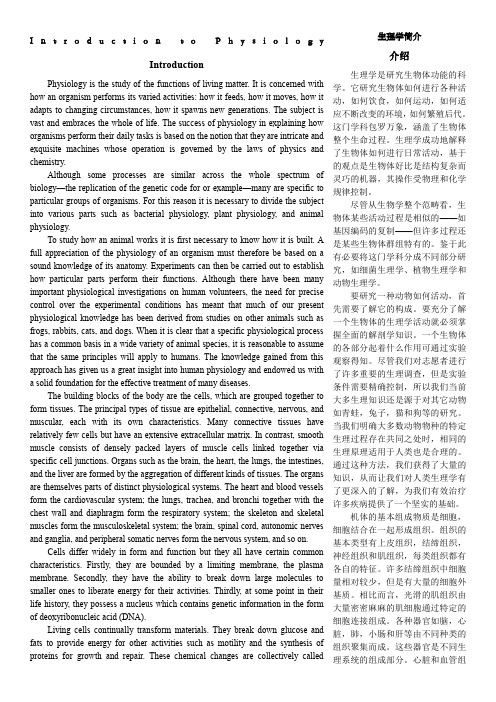
I n t r o d u c t i o n t o P h y s i o l o g yIntroductionPhysiology is the study of the functions of living matter. It is concerned with how an organism performs its varied activities: how it feeds, how it moves, how it adapts to changing circumstances, how it spawns new generations. The subject is vast and embraces the whole of life. The success of physiology in explaining how organisms perform their daily tasks is based on the notion that they are intricate and exquisite machines whose operation is governed by the laws of physics and chemistry.Although some processes are similar across the whole spectrum of biology—the replication of the genetic code for or example—many are specific to particular groups of organisms. For this reason it is necessary to divide the subject into various parts such as bacterial physiology, plant physiology, and animal physiology.To study how an animal works it is first necessary to know how it is built. A full appreciation of the physiology of an organism must therefore be based on a sound knowledge of its anatomy. Experiments can then be carried out to establish how particular parts perform their functions. Although there have been many important physiological investigations on human volunteers, the need for precise control over the experimental conditions has meant that much of our present physiological knowledge has been derived from studies on other animals such as frogs, rabbits, cats, and dogs. When it is clear that a specific physiological process has a common basis in a wide variety of animal species, it is reasonable to assume that the same principles will apply to humans. The knowledge gained from this approach has given us a great insight into human physiology and endowed us with a solid foundation for the effective treatment of many diseases.The building blocks of the body are the cells, which are grouped together to form tissues. The principal types of tissue are epithelial, connective, nervous, and muscular, each with its own characteristics. Many connective tissues have relatively few cells but have an extensive extracellular matrix. In contrast, smooth muscle consists of densely packed layers of muscle cells linked together via specific cell junctions. Organs such as the brain, the heart, the lungs, the intestines, and the liver are formed by the aggregation of different kinds of tissues. The organs are themselves parts of distinct physiological systems. The heart and blood vessels form the cardiovascular system; the lungs, trachea, and bronchi together with the chest wall and diaphragm form the respiratory system; the skeleton and skeletal muscles form the musculoskeletal system; the brain, spinal cord, autonomic nerves and ganglia, and peripheral somatic nerves form the nervous system, and so on.Cells differ widely in form and function but they all have certain common characteristics. Firstly, they are bounded by a limiting membrane, the plasma membrane. Secondly, they have the ability to break down large molecules to smaller ones to liberate energy for their activities. Thirdly, at some point in their life history, they possess a nucleus which contains genetic information in the form of deoxyribonucleic acid (DNA).Living cells continually transform materials. They break down glucose and生理学简介介绍生理学是研究生物体功能的科学。
人体生理学HumanPhysiology

血量
❖ 是指全身血液的总量 ❖ 占体重的7-8%
休克种类的图示。 没有休克 (左), 血管扩张,分布性休克 (中), 低血容量休克,失血引起 (右)
血液的功能
• 运输
– O2 and CO2 – Nutrients (glucose, lipids, amino acids) – Waste products (e.g., metabolites) – Hormones
Reflex Arc
•Receptor •Afferent (sensory) nerve •Reflex center (brain or spinal cord) •Efferent (motor) nerve •Effector
体液调节Humoral regulation
是指体内某些特殊的化学物质通过体液途径而影响 生理功能的一种调节方式
稳态Homeostasis
v 定义:
稳态是指内环境的理化 性质,如温度、pH、渗 透压和各种液体成分等 的相对恒定状态
v 稳态的维持是机体自我 调节的结果
v 稳态概念已经大大扩展
Walter B. Cannon
/wiki/Walt er_Bradford_Cannon
• 调节
– pH – Body temperature
绪论 细胞的基本功能
内环境与稳态
❖ 外环境External environment 整个机体所处的环境
❖ 内环境Internal environment 围绕在多细胞动物体内细胞 周围的体液
Claude Bernard
/wiki/Claude_Bernard
血液的成分
• Plasma(血浆) • Blood Cells
Renal Physiology
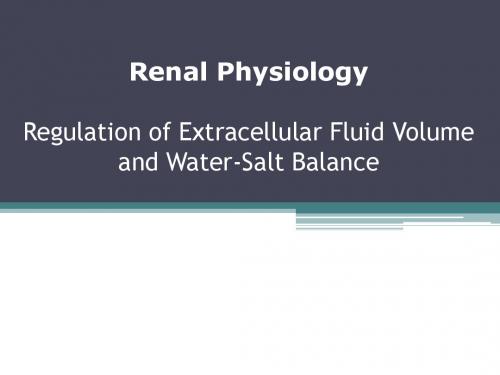
Objectives
• Describe the cellular action of ADH and aldosterone • Know about the regulation and secretion of ADH and aldosterone
第一阶段问题
• 脑水肿的表现是什么?病因是什么?脑水肿的发生与组织液的生成有 何关系?脑水肿有何危害?CT如何判断脑水肿? • 正常血钠浓度是多少?高血钠、低血钠的诊断标准是什么?血钠是如 何调节的?血钠保持稳定有何生理意义?高血钠对人体有何影响?高 血钠是由脑水肿导致的还是有其它原因? • 尿液是如何产生的?正常尿量是多少?正常尿渗透压和比重是多少? 正常人体尿生成的神经体液控制机制是怎样的?中枢内哪些部位可以 调节尿的生成? • 什么是尿崩症?如何诊断?有何类型?其产生原因和表现是什么?尿 崩症对体液平衡有何影响?为什么病人三天后才出现尿崩症?尿崩症 的治疗措施? • 多尿是肾小管重吸收的改变还是肾小球滤过因素的变化导致的? • 高血钠与尿崩症的因果关系? • 头部创伤为什么引起尿崩症?尿崩症与抗利尿激素分泌有什么关系?
Key words(关键词)
• • • • • • 3 days ago(3天之后) head trauma(头部创伤) cerebral swelling(脑水肿) hypernatremia(高血钠) dilute urine(稀释尿) central diabetes insipidus(中枢性尿崩症)
Renal Physiology Regulation of Extracellular Fluid Volume and Water-Salt Balance
Case
• A 27-year-old woman is being monitored in the intensive care unit after sustaining head trauma(头部创伤) in a motor vehicle accident 3 days ago. She has undergone computed tomographic imaging(计算机断层摄影) of her head, which has shown cerebral swelling(脑水肿) but stable condition. The nurse calls the physician because the patient has developed hypernatremia(高血钠) and has had a significant increase in dilute urine(稀释尿) output. The findings are confirmed, and it is determined that the patient has central diabetes insipidus(中枢性尿 崩症) as a result of the head trauma.
医学英语经典教程(人文分册)

医学英语经典教程(人文分册)介绍医学英语是医学领域必不可少的一门重要语言,它不仅帮助医学专业人员与国际同行进行交流,还有助于学习和了解国际先进的医学研究和技术。
本教程以人文分册为主题,旨在帮助学习者掌握医学英语中与人文相关的词汇、表达和文化背景等内容。
通过本教程的学习,学生将能够更好地与患者、医学文献以及国际医疗团队进行交流。
目录1.人体解剖与生理学2.医学伦理与医患关系3.健康与生活方式4.医学文化与传统5.跨文化沟通与医疗援助人体解剖与生理学在医学领域,准确的人体解剖与生理学知识对于正确理解病理生理过程和诊断治疗非常重要。
本章将介绍与人体解剖和生理学相关的医学英语词汇及其表达方式。
学习者将通过阅读医学文献和案例分析来掌握这些词汇,并能够准确地描述人体各个系统的结构和功能。
医学伦理与医患关系医学伦理是医学实践中至关重要的一部分,它涉及到医生、患者和医疗机构等多方面的利益和责任。
本章将介绍医学伦理与医患关系方面的英语词汇和表达方式。
学习者将了解到医学伦理的基本原则、医疗道德的重要性以及患者权益保护的相关知识。
健康与生活方式健康和生活方式直接关系到个体的身体状况和健康风险。
本章将介绍与健康和生活方式相关的医学英语词汇和表达方式,包括健康评估、健康教育和生活习惯等方面的内容。
学习者将能够更好地理解健康信息,掌握主动健康管理的技巧。
医学文化与传统不同国家和文化背景下的医学文化和传统对于医学英语的理解和运用有着重要影响。
本章将介绍与医学文化和传统相关的医学英语词汇和表达方式,以及不同文化习俗对医疗行为的影响。
学习者将能够增进对不同文化医学实践的了解,并提高文化敏感性。
跨文化沟通与医疗援助在国际医疗团队中,跨文化沟通和医疗援助能力至关重要。
本章将介绍与跨文化沟通和医疗援助相关的医学英语词汇和表达方式,包括国际医疗援助、医疗翻译和文化中介等方面的内容。
学习者将能够更好地与国际同行合作,提供高质量的医疗服务。
生理学Physiology研究报告
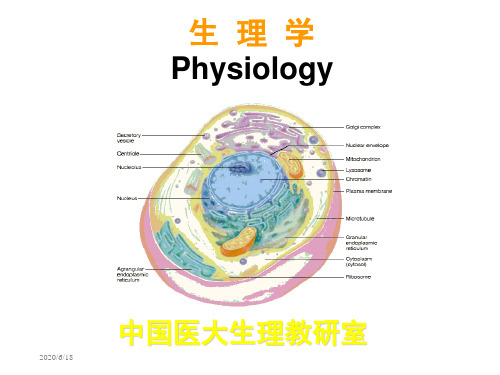
四、前馈控制系统 feed-forward control 控制部分向受控部分发出指令进行某一活 动的同时,经另一快捷途径向受控部分发 出发出“前馈”信号,使受控部分在接受
控 制部分指令进行活动时,又及时地受到前 馈信号的调控,从而活动更加准确。
如:条件反射。 2020/6/18
非自动控制系统:仅为指令、开环系统 反馈控制系统: 自控、闭环系统
(closed loop system)
前馈控制系统
2020/6/18
二、非自动控制系统
Non-automatic control system
特点: 1.是开环系统(open loop system) 2.单向控制:仅由控制部分发出指令, 控制受控部分活动 3.此方式在人体生理功能调节少见,仅 在体内反馈调节受抑制时发生。如: 应激情况下,减压反射被抑制→应激 刺激引起交感系统(+)→BP↑,HR↑
二、生理学研究的水平 1.细胞和分子水平 2.器官和系统水平 3.整体水平
三、生理学的研究方法: 急性实验 acute experiment 慢性实验 chronic experiment 在体 (in vivo);离体(in vitro )
2020/6/18
(二)机体的内环境 Internal environment 细胞直接生存的体内环境。 指细胞外液
2020/6/18
二、体液调节 humoral regulation 1.体液调节概念 (concept) 2.激素 (hormone) 3.受体 (receptor) 4.靶细胞 (target cell) 5.远距分泌 (telecrine) 6.旁分泌 (paracrine) 7.神经分泌(neurosecretion or neurocrine)
医用生理学概要英文版
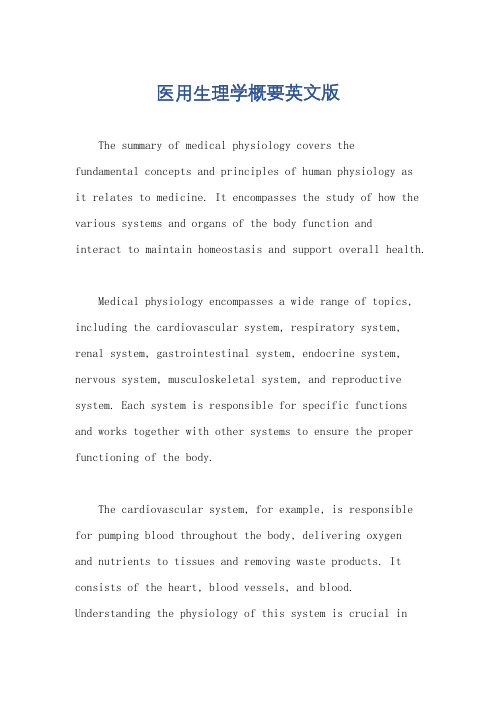
医用生理学概要英文版The summary of medical physiology covers the fundamental concepts and principles of human physiology asit relates to medicine. It encompasses the study of how the various systems and organs of the body function andinteract to maintain homeostasis and support overall health.Medical physiology encompasses a wide range of topics, including the cardiovascular system, respiratory system, renal system, gastrointestinal system, endocrine system, nervous system, musculoskeletal system, and reproductive system. Each system is responsible for specific functions and works together with other systems to ensure the proper functioning of the body.The cardiovascular system, for example, is responsible for pumping blood throughout the body, delivering oxygenand nutrients to tissues and removing waste products. It consists of the heart, blood vessels, and blood. Understanding the physiology of this system is crucial indiagnosing and treating cardiovascular diseases.The respiratory system is responsible for the exchangeof oxygen and carbon dioxide in the body. It includes the lungs, airways, and respiratory muscles. Knowledge of respiratory physiology is essential in managing respiratory disorders and optimizing respiratory function.The renal system plays a crucial role in maintaining fluid and electrolyte balance, filtering waste productsfrom the blood, and regulating blood pressure. It consistsof the kidneys, urinary tract, and associated blood vessels. Understanding renal physiology is vital in diagnosing and managing kidney diseases and maintaining overall fluid and electrolyte homeostasis.The gastrointestinal system is responsible for the digestion and absorption of nutrients, as well as the elimination of waste products. It includes the mouth, esophagus, stomach, intestines, liver, and pancreas. Knowledge of gastrointestinal physiology is essential in diagnosing and managing digestive disorders and optimizingnutritional status.The endocrine system consists of various glands that secrete hormones, which regulate various bodily functions. These glands include the pituitary gland, thyroid gland, adrenal glands, and pancreas, among others. Understanding endocrine physiology is crucial in diagnosing and managing endocrine disorders and maintaining hormonal balance.The nervous system is responsible for coordinating and controlling bodily functions. It includes the brain, spinal cord, and peripheral nerves. Understanding the physiology of the nervous system is essential in diagnosing and managing neurological disorders and optimizing neurological function.The musculoskeletal system provides support, movement, and protection to the body. It includes bones, muscles, tendons, ligaments, and joints. Knowledge of musculoskeletal physiology is important in diagnosing and managing musculoskeletal disorders and optimizing physical performance.The reproductive system is responsible for the production of offspring. It includes the male and female reproductive organs and hormones. Understandingreproductive physiology is crucial in diagnosing and managing reproductive disorders and optimizing fertility.In summary, medical physiology encompasses the study of how the various systems and organs of the body function and interact to maintain homeostasis and support overall health. It is a fundamental aspect of medical education and plays a vital role in diagnosing and managing diseases.。
physiology相关知识点
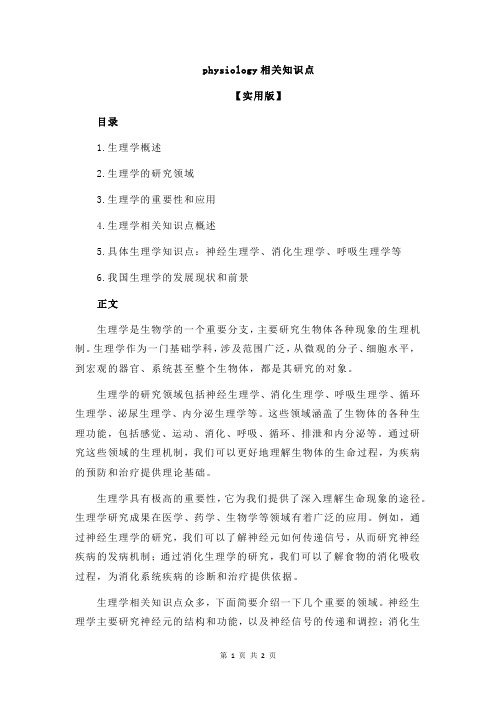
physiology相关知识点【实用版】目录1.生理学概述2.生理学的研究领域3.生理学的重要性和应用4.生理学相关知识点概述5.具体生理学知识点:神经生理学、消化生理学、呼吸生理学等6.我国生理学的发展现状和前景正文生理学是生物学的一个重要分支,主要研究生物体各种现象的生理机制。
生理学作为一门基础学科,涉及范围广泛,从微观的分子、细胞水平,到宏观的器官、系统甚至整个生物体,都是其研究的对象。
生理学的研究领域包括神经生理学、消化生理学、呼吸生理学、循环生理学、泌尿生理学、内分泌生理学等。
这些领域涵盖了生物体的各种生理功能,包括感觉、运动、消化、呼吸、循环、排泄和内分泌等。
通过研究这些领域的生理机制,我们可以更好地理解生物体的生命过程,为疾病的预防和治疗提供理论基础。
生理学具有极高的重要性,它为我们提供了深入理解生命现象的途径。
生理学研究成果在医学、药学、生物学等领域有着广泛的应用。
例如,通过神经生理学的研究,我们可以了解神经元如何传递信号,从而研究神经疾病的发病机制;通过消化生理学的研究,我们可以了解食物的消化吸收过程,为消化系统疾病的诊断和治疗提供依据。
生理学相关知识点众多,下面简要介绍一下几个重要的领域。
神经生理学主要研究神经元的结构和功能,以及神经信号的传递和调控;消化生理学主要研究消化系统的功能和调节,包括口腔、食管、胃、肠和肝脏等;呼吸生理学主要研究呼吸系统的功能和调节,包括鼻腔、喉、气管、支气管和肺等。
我国生理学的发展有着悠久的历史,近年来在国家政策的支持和优秀科研人员的努力下,取得了一系列重要成果。
目前,我国生理学研究已经逐渐与国际接轨,前景十分广阔。
现实疗法魏广东编

现实疗法讲义(Reality Therapy)魏广东编2010年3月5日北京自序我感觉,心理咨询犹如佛学的发展,流派林立,技法众多,出现这样的状况,或许也是心理学欣欣向荣而非死水一潭的表征。
但是这苦了学习心理学和运用心理学的人,尤其是心理咨询师,经常忙碌于各种心理咨询技术的学习之中而不能自拔。
实际上,心理咨询师作为一个职业,与其他职业一样,也需要进行认真的职业规划,而且这个规划不仅仅要设计好自己的发展模式和途径,还要做好学习深造的统筹规划。
此外,我也比较提倡“不怕千招会,就怕一招鲜”,心理咨询师要在比较全面了解心理咨询的基本理论、基本流派和不同技巧(掌握这些知识完全可以通过看书方式实现)的基础上,重点学习、实践某一两个技术,而不是所有的技术都学习。
不仅如此,在计划学习一个新的心理咨询技术的之前,还要好好考察这一方法是否方便使用,是否符合当前国情和行情(行业情况)。
假如一个技术,需要你雇佣好几个人来为一个人服务——除非极高收费——那肯定就不是很便于在咨询中心使用的。
在我看来,现实疗法就是众多值得学习和运用的疗法之一。
现实疗法产生于上世纪六十年代,发展成熟与上世纪七、八十年代,在国外已经有了较为广泛的应用。
但是,现实疗法在国内还基本上没怎么被运用,在“中国知网”进行相关论文的搜索,只能找到20篇论文,在其他网站也未搜索到相关的教育和培训。
可见,现实疗法对于中国心理咨询行业来讲,还算是一个未开垦之地。
一方面现实疗法是一个很好的方法,另外一方面现实疗法在国内又没有被广泛介绍,所以,我整理编辑了《现实疗法讲义》。
这一讲义的资料主要来源于翻译的国外的文献资料,并参考了能找到的国内学者们的论文,希望能够为心理咨询师同行们提供学习参考。
目前,国内不仅没有相应的培训,甚至都没有翻译现实疗法的书籍,所以,也希望能与有关组织或者机构一起把这门技术普及开来。
本人水平有限,欢迎批评指正。
魏广东中国石油大学(北京)心理咨询中心讲师北京师范大学发展与教育心理学专业硕士国家二级心理咨询师中国心理学会会员北京师范大学家庭咨询与治疗中心心理咨询师E-mail:QQ:2010年3月5日北京目录自序...................................................... 错误!未定义书签。
- 1、下载文档前请自行甄别文档内容的完整性,平台不提供额外的编辑、内容补充、找答案等附加服务。
- 2、"仅部分预览"的文档,不可在线预览部分如存在完整性等问题,可反馈申请退款(可完整预览的文档不适用该条件!)。
- 3、如文档侵犯您的权益,请联系客服反馈,我们会尽快为您处理(人工客服工作时间:9:00-18:30)。
Afferent arteriole:no O2 and nutrients used Glomerulus: a tuft capillaries Efferent arteriole Peritubular capillaries:supply blood
Bowman’s capsule: cups around Proximal tubule:in cortex Loop of Henle Distal tubule and collecting duct
Glomerular filtration Tubular reabsorption Tubular secretion
Urine formation
Afferent artery glomerular
2.75L
Efferent artery
Glomerular filtration
20% of the plasma that enters the glomerulus is filtered.
(2)Basement membrane (collagen and glycoproteins) (3)The inner layer of Bowman’s capsule
Glomerular filtration
ECF
Simple marine organ
ECF: sea-maintain constant ECF: kidney maintain water and electrolyte balance within very narrow range
Terrestrial animals
Major Functions of the Kidneys
Regulation of:
body fluid osmolarity and volume electrolyte balance acid-base balance blood pressure
metabolic products foreign substances (pesticides, chemicals etc.) excess substance (water, etc)
The structure of nephron
Cortical nephron or Juxtamedullary nephron ?
Juxtaglomerular apparatus
Juxtaglomerular apparatus
Juxtaglomerular apparatus
Proximal tubule Loop of Henle Distal tubule
Collecting duct
Renal pelvis
Cortical nephron and Juxtamedullary nephron
Regional differences in nephron structure
Filtration rate(180L/d) -Reabsorption rate(178.5L/d) + Secretion rate Note: do not confuse excretion with secretion
Glomerular
filtration
Urine formation
Excretion of
Major Functions of the Kidneys
Secretion of
erythropoietin 1,25-dihydroxy vitamin D3 renin prostaglandin
Structure of kidney
Gross Anatomy of the Kidney
Kidney -- nephron
Renal cortex Renal pyramid Renal medulla
nephron
Renal pelvis Ureter Renal pyramid
Structure of nephron
Vascular component
Tubular component
Vesa recta
The efferent arterioles are the only arterioles in the body that drain from capillaries
Urine formation
Urine formation
Basic three procedures
Afferent arteriole
Efferent arteriole
Lumen of glomerular capillary
Proximal tubule
Glomerular filtration
Layers of glomerular membrane
(1)The wall of the glomerular capillaries (pore: more permeable)
Cortical nephron (80-90%)
Glomuruli lie in the outer layer of the cortex Hairpin loop dips only slightly in the medulla Peritubular capillaries entwine around short loops of Henle Glomeruli lie in the inner layer of the cortex Hairpin loop plunges entire depth of the medulla
Structure of Nephron
Nephron
Renal corpuscle
Glomerulus Bowman’s capsule
Renal tubular system
Collecting duct
Structure of kidney
Nephron
Renal corpuscle Renalell(specialized vascular cells): secretion renin Macula densa(specialized tubular cells):
Mesangial cell
sensing change in ECF volume↓/[NaCl] ↓/ blood pressure↓ Control renin release Function as phagocytes Contraction : close off the filtration capillaris (sympathetic nerve excitation)
Structure of kidney
The nephron is the functional unit of the kidney:
1 million microscopic functional unit Perform almost all kidney’s functions Distinction between the cortical and medullary regions of the kidney
Active transport
Urine formation
Urinary excretion refers to the elimination of substances from the body in the urine Urinary excretion rate(1.5L/d)
Juxtamedullary nephron(10-20%)
For establishment of the medullary vertical osmotic gradient
Peritubular capillaries form vasa recta and run in closely with long loops of Henle
Blood supply to kidney
Blood supply to kidney
Features of the renal blood flow:
abundant blood flow 1200ml/min Two capillary beds
High hydrostatic pressure in glomerular capillary (about 60 mm Hg)--filtration low hydrostatic pressure in peritubular capillaries (about 13 mm Hg)—reabsorption
Glomerular filtration
Structure:glomerular membrane Force:effective filtration pressure
Glomerular filtration
Glomerular membrane Filtration fluid=proteins-free glomerulus blood plasma into Bowman’s capsule Bowman’s capsule Permeability is 100 times more than capillary elsewhere Filtration occurs through entire length of capillary
